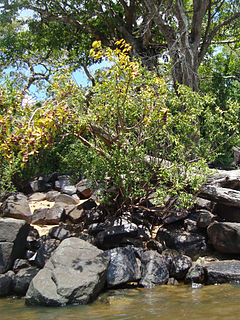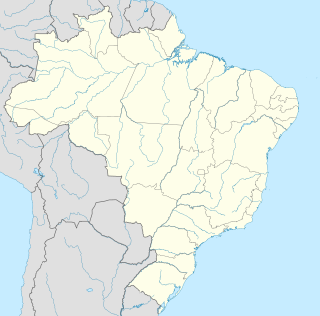
Myrciaria dubia, commonly known as camu camu, camucamu, cacari, or camocamo, is a species of plant in the family Myrtaceae. It is a small bushy riverside tree from the Amazon rainforest in Peru and Brazil, which grows to a height of 3–5 m (9.8–16.4 ft) and bears a red/purple cherry-like fruit. It is a close relative of the jabuticaba and the guavaberry or rumberry. As much as 2-3% of the fresh fruit by weight is vitamin C.

Myrciaria floribunda, commonly known as cambuizeiro, guavaberry or rumberry, is a species of plant in the family Myrtaceae. It can be found across south and central america in dry or moist coastal woodlands, up to 300 metres above sea level. The guavaberry, which should not be confused with the guava, is a close relative of camu camu.

Araguapaz is a municipality in northwestern Goiás state, Brazil. The population is 7,783 (2020) in a total area of 2,194 km2. It is a major producer of cattle.

Hidrolândia is a municipality in central Goiás state, Brazil. The population was 22,124 (2020) in a total area of 944.2 km2 (364.6 sq mi). Hidrolândia is a large producer of poultry and eggs.

Myrciaria is a genus of large shrubs and small trees described as a genus in 1856. It is native to Central and South America, Mexico, and the West Indies, with many of the species endemic to Brazil. Common names include hivapuru, sabará, and ybapuru.
Myrciaria cuspidata, commonly known as camboim, or cambuím is a species of plant in the family Myrtaceae. It is found in coastal forests and semideciduous forests in Brazil, Paraguay and Argentina. It grows slowly to a semideciduous shrub or small tree, between 3 and 6 metres tall, with orange or black berries around 10mm in diameter.
Myrciaria plinioides, commonly known as camboim, cambuim, or cambuí, is a species of plant in the family Myrtaceae. It is a shrub that is endemic to Rio Grande do Sul in the south of Brazil.

Senador Amaral is the second highest city in Brazil, reaching near 1,620 m (5,310 ft) in some parts in the northern areas, nearly the Ponte Segura district, the highest point is an unnamed mount in Bom Repouso border at approximately 1660m above sea level. It is located in the Mantiqueira Mountains, south of Minas Gerais state. It is a small city, with a population of 5,361 inhabitants and approximately 2980 people living in the urban area. Has not asphalt and mobile phone signal in the municipality before 2007. Only Cambuí access, MG-295 is asphalted.

Cambuí is a municipality in the state of Minas Gerais in the Southeast region of Brazil.

Ibirapuitã Biological Reserve is a state-operated biological reserve in the State of Rio Grande do Sul, Brazil.
Cambuím, camboim, or cambuí are the common names for a number of species of plant in the family Myrtaceae.
Myrciaria delicatula, commonly known as cambuí uvaia doce, cambuí graudo, cambuim, or cambu branco, is a species of plant in the family Myrtaceae. It is found in araucaria moist forests, gallery forests and grasslands in Argentina, Paraguay, Bolivia, and southern and eastern Brazil. It grows slowly to a semideciduous shrub or small tree, between 4 and 10 metres tall. M. delicatula produces edible black berries around 10mm in diameter, the flavour of which has been compared to that of Eugenia pyriformis.

Myrciaria glomerata, commonly known as cabeludinha-vermelha or cabeluda-escarlate, is a species of plant in the family Myrtaceae. It is an evergreen shrub or small tree, endemic to the north and east of Brazil. Myrciaria glomerata has historically been used to incorrectly describe Myrciaria glazioviana.
Myrciaria tenella, commonly known as cambuí or camboim, which are also used to describe Myrciaria cuspidata and Myrciaria delicatula; or more specifically jabuticaba-macia, and cambuí-açu, is a species of plant in the family Myrtaceae.
Myrciaria pallida is a species of plant in the family Myrtaceae. It is endemic to the south-east of Brazil.
Myrciaria cambuca is a species of plant in the family Myrtaceae. It is endemic to the coastal forest of eastern Brazil. First described in 2019, it is a small shrub with redish fruit, and was previously misidentified as Myrciaria ferruginea.
Myrciaria rupestris is a species of plant in the family Myrtaceae. It is endemic to west Cuba. Plinia rubrinervis and Plinia rupestris were transfered to Myrciaria as this single species in 2014.
Myrciaria puberulenta is a species of plant in the family Myrtaceae. It is endemic to southern Venezuela and was first described in 2002.
Myrciaria myrtifolia, commonly known as the ridgetop guavaberry, is a species of plant in the family Myrtaceae. It is endemic to Puerto Rico and it was first described in 1983. It is a shrub found mainly at low elevations, in mountain foothills in the south-east, and coastal plains in the south-west.
Myrciaria glanduliflora is a species of plant in the family Myrtaceae. It is endemic to Minas Gerais, Brazil, and was first described in 1975.








